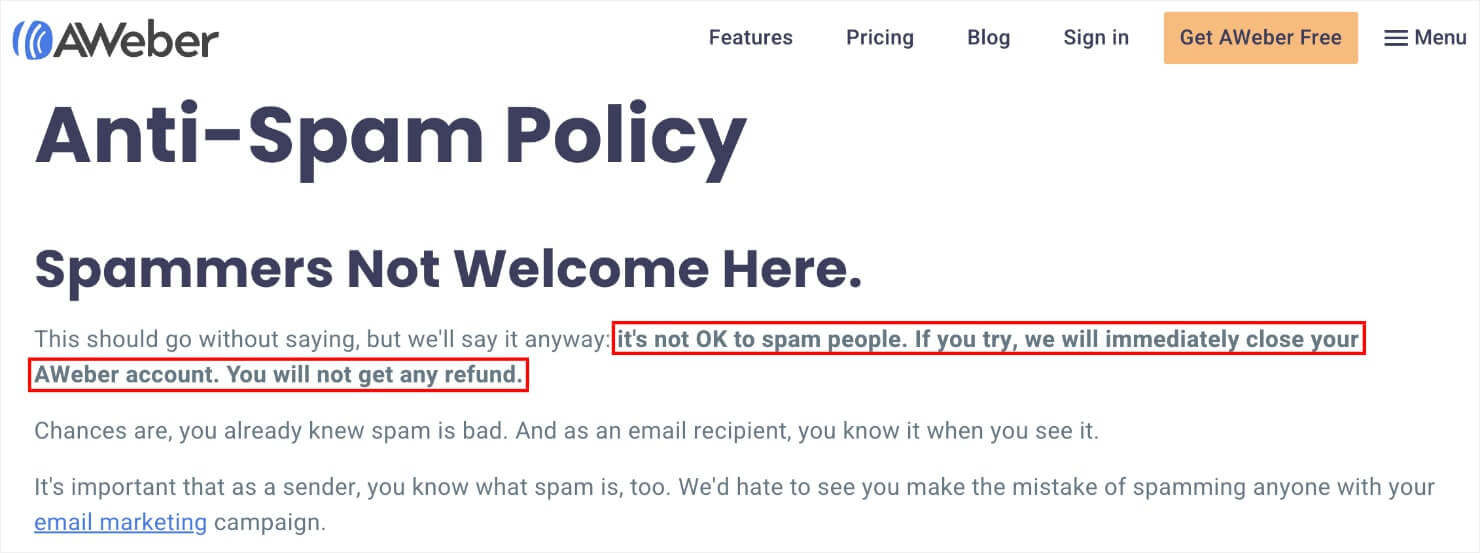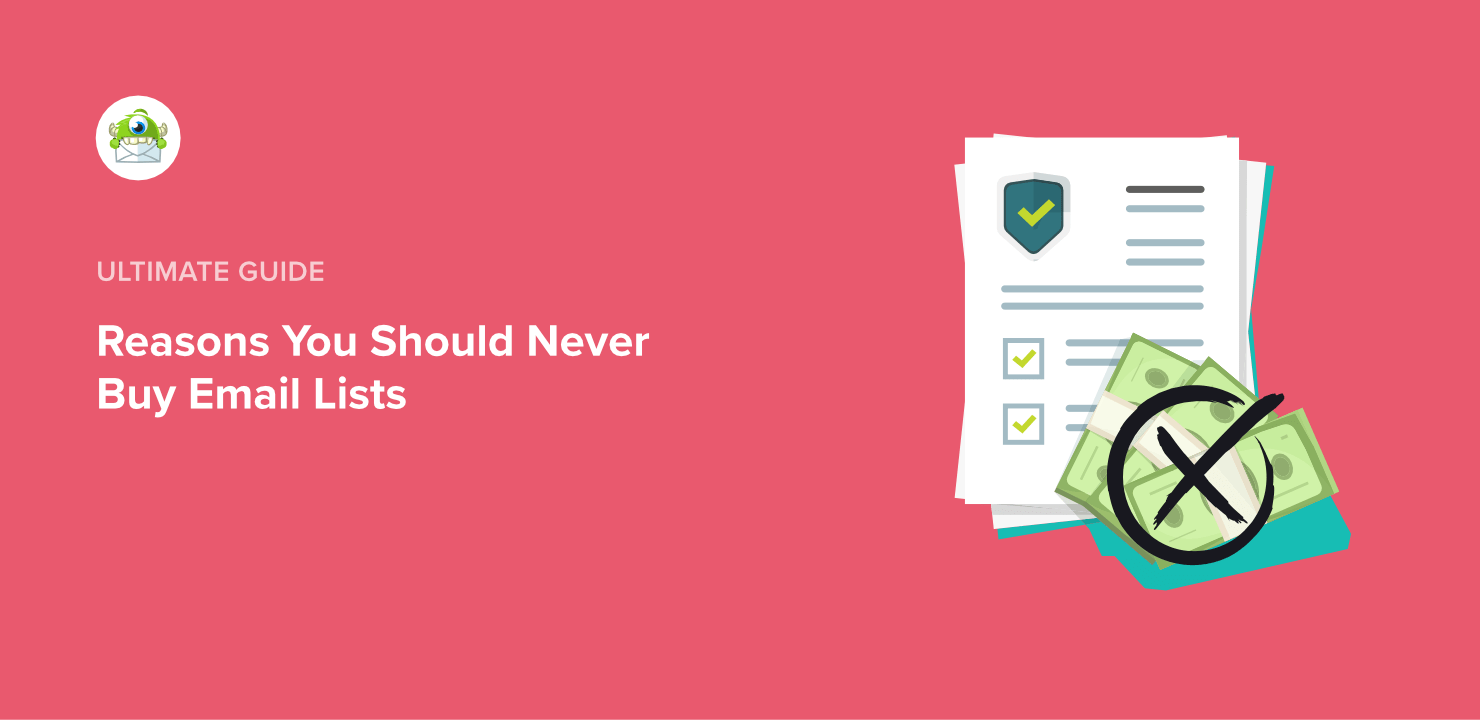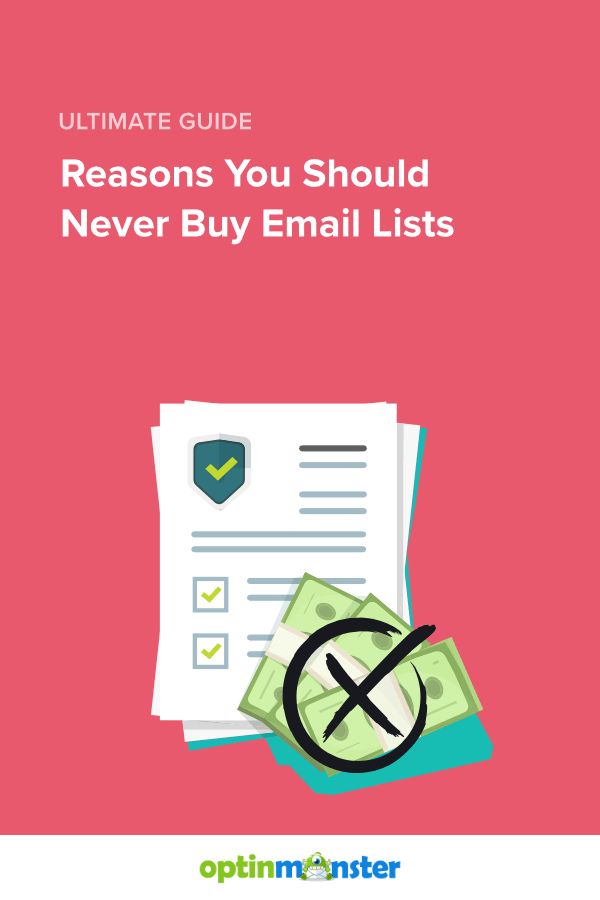Are you considering buying an email list to find potential customers for your business? Our suggestion: Don’t do it.
Buying an email list sounds like a quick way to grow your revenue potential. But it is a huge waste of time and money. In this post, we’ll share 8 reasons why you should never buy an email list (and what to do instead).
What Does It Mean to “Buy Email List”?
Why You Should Never Buy an Email List
Don’t Buy Email List, Build One for Free Instead
What Does It Mean to “Buy Email List”?
An email list includes a list of names, email addresses, and perhaps other demographic data like company name or income level. You can buy these lists from email database providers like ZoomInfo and Apollo.
Smaller marketing agencies that scrap email data from platforms like LinkedIn also sell email marketing lists online.
Since email marketing is the #1 way to sell anything online, many amateur business owners buy a list of emails to run their email marketing campaigns.
If you set to create an organic email list with thousands of customer data on your own, it would take several months. But when you buy an email list online, you get instant access to hundreds or thousands of customer data.
But is buying email lists worth it?
Short answer: no.
Buying an email list is a really bad idea and a huge waste of money. It’s one of those hacks that simply doesn’t work and will likely cause your business far more harm than good.
Why You Should Never Buy Email List
Here are 8 reasons why you should never purchase an email list.
- You Can’t Trust the Quality of the List
- You Might Have to Pay Hefty Fines
- You’ll Come Across as a Spammer
- Email Marketing Platforms Can Ban You
- You’ll Risk Your Brand Reputation
- Other Brands Might Use the Exact Same List
- Your Response Rate Will Suffer a Lot
- No Reputable Expert Recommends It
1. You Can’t Trust the Quality of the List
Buying an email list is not like building a quality email list from the ground up. You get a ton of junk leads when you buy a second-hand email list. Purchasing email lists also poses several other problems, such as:
- Missing or incomplete data: There’s a high chance that the email list has wrong names and email addresses.
- Out-of-date information: Depending on how old the email marketing list is, it might include email addresses that no longer exist or are abandoned.
- Illegally sourced email addresses: Many email list sellers scrap social media platforms like LinkedIn to curate the email addresses of people without their consent. Using these email addresses for your marketing campaigns is against the CAN-SPAM Act (Controlling the Assault of Non-Solicited Pornography And Marketing Act of 2003).
Businesses that buy contact lists might think getting 5,000–10,000 email addresses overnight is like hitting a jackpot. But an email address list is pretty worthless if it has outdated, incorrect, and unlawful lead data.
2. You Might Have to Pay Hefty Fines
Buying email lists isn’t illegal. But how you use the email data can land you in costly legal battles.
Most countries have stringent laws against sending unsolicited bulk emails, such as the CAN-SPAM Act in the USA.
If the email list you buy violates the CAN-SPAM Act, you can pay a fine of up to $50,120 for each separate email you send:

General Data Protection Regulation (GDPR) is a similar data protection law in the European Union (EU) that has specific clauses against spam. GDPR states that you need people’s consent to contact them through email.
But when you buy an email list from 3rd-party vendors, you don’t have the explicit consent of people included in that list. That’s a violation of GDPR’s data privacy rule. As a result, you might have to pay up to 10 million euros or 2% of your entire global revenue, whichever is higher.
Facebook’s parent company Meta forked up $1.3 billion in early 2023 after it violated the GDPR rule against processing people’s personal data from the EU to the USA.
Canada has Canadian Anti-Spam Legislation (CASL) that has similar prohibitions to encourage permission-based email marketing.
Different countries have different laws around spam. If the email list you buy includes people from a country that has anti-spam laws, you’ll have to abide by those laws.
3. You’ll Come Across as a Spammer
Your emails might be well-written and valuable. It might have the best subject lines and call-to-action (CTA) buttons optimized for conversions.
But email outreach works best when people receiving your emails can recall your brand. That’s rarely the case with purchased email lists.
For recipients who don’t know your brand, you’re just an unknown company spamming their inbox. Customers either delete or unsubscribe to emails from brands they don’t know. Many will mark unsolicited emails as spam to stop getting those emails in the future (more on this in the next heading).
Research says that marketing messages are the most common type of spam, which makes up 36% of all spam emails. In 2022 alone, we saw over 162 billion spam emails sent daily!
Too many people reporting your marketing emails can hurt your email deliverability and IP reputation. Email verification and spam blocklist databases like Spamhaus and Spamcop can flag your IP address and blacklist your domain.
Pro-tip Do you want to learn how to improve your email’s reach? Follow the email deliverability best practices.
4. Email Marketing Platforms Can Ban You
When people start mass reporting your emails as spam, you get on the wrong side of your email marketing platforms.
These are marketing automation platforms such as AWeber, ConvertKit, or Constant Contact that integrate with your CRM and let you manage your email marketing campaigns.
Most email marketing platforms have strict policies that forbid users from buying business email marketing lists. They can close your account, impose a fine on your brand, or start legal action against you if you violate the rules.
Here’s an example.
Aweber considers buying email lists as spamming, and it is a serious violation of their service agreement. It has explicit warnings against the use of spam on its website.

Email service providers (ESPs) like Gmail and Yahoo! also discourage businesses from sending emails without people’s consent. The ESPs might mark your email messages as spam or suspend your business account without prior notice.
5. You’ll Risk Your Brand Reputation
Besides email marketing platforms banning you, buying an email list is also a serious risk to your brand reputation.
A lot of customers take to social media to rant about brands that send too many spam emails. Even worse, your brand name can become synonymous with spam and can get ranked in the list of companies that send the most spam.
Creating a respectable brand is crucial, and you don’t want to spend huge amounts of money on damage control later.
6. Other Brands Might Use the Exact Same List
To maximize their profits, email list providers sell the same set of email contacts to multiple buyers. It’s one of the reasons why they sell business email lists at a discount.
Using duplicate lists affects your conversion rates and other marketing metrics in the long term. Imagine 5–10 brands bombarding marketing emails to the same set of people. It gets annoying and creates a bad customer experience.
These recipients are unlikely to buy from you or interact with you, no matter how appealing your offer is. Many of them might even put spam filters in place to never see your emails in the future.
7. Your Response Rate Will Suffer a Lot
Let’s say you have an eCommerce store that sells a product for $20 per unit. You buy an email list of 10,000 names. You figure that on a 5% conversion rate, you’ll sell 500 units of your new product, which gets you $10,000.
Not bad, right?
Well, your response rate will likely be far lower than 5%. In reality, most people on purchased lists don’t even open your email, let alone click on the call-to-action buttons in your email.
Purchased email lists have far lower open and click-through rates. Statistically speaking, only 1 out of 12,500,000 emails convert successfully. That’s because 74% of buyers hate receiving irrelevant emails.
Contrast that with the average email open rates of 20–25% for healthy, targeted email lists.
Pro-tip Are you looking for ways to improve your eCommerce conversion rate? Read our guide on the ultimate eCommerce optimization tips.
8. No Reputable Expert Recommends It
On most marketing topics, people have differences of opinion about which strategies work and which don’t. But everyone agrees that buying an email list is not worth it.
Read any major blog on email marketing, and you’ll get the same validation from all of them: Don’t purchase email lists.
Here’s what experts have to say on the topic of purchased email lists:
“Purchased lists are ticking time bombs, waiting to devastate your reputation as a sender. Riddled with dead emails and spam traps, they quickly inform mailbox providers that you break the rules by sending unsolicited emails. If you still buy email lists, STOP NOW.”
– Neil Patel, YouTube Content Creator and Co-Founder of Crazy Egg, Kissmetrics, and Hello Bar
“It’s tempting because you want to do it fast. But you don’t want to be in the business of spamming people. Unsolicited emails are not how you want to get out there. You want to build relationships.”
– Evan Carmichael, Author and YouTube Content Creator
“There is too much to lose when you use this method to obtain leads for your small business. If you want to maintain a relevant customer base, follow the law, and keep your reputation, work on building your own email list from scratch.”
– Syed Balkhi, Founder of WPBeginner, WPForms, and OptinMonster
To summarize, buying emails is a waste of money and marketing efforts that can affect your brand awareness negatively.
Don’t Buy Email List, Build One for Free Instead
The best alternative to buying email lists is building targeted email lists from scratch. Building an audience should be a priority in your digital marketing strategy, and list-building is the best way to achieve it.
Targeted list building helps you create a strong inbound marketing strategy instead of relying too much on outbound channels like cold emails, cold calling, and paid advertising.
In the long run, an inbound marketing strategy like driving website traffic through blogs is more scalable and cost-effective because it’s organic.
But if you’re just starting, you might not be sure where to begin. Here’s an easy step-by-step guide to building your email list organically.
Step 1: Build an Audience With Engaging Content
Every brand has something of value that they can offer to their target market. Use your expertise to trade good content for customers’ contact information, like email addresses and phone numbers.
If you don’t have a website yet, start there. Publish high-quality content like blogs, videos, tutorials, or infographics to drive relevant traffic to your website.
Next, create an optin campaign to let people join your email list.
When you create engaging content that’s relevant to your target audience, they are more than willing to subscribe to your email newsletters or blogs.
This builds trust, and you can easily sell your products or services to your subscribers without much friction.
Step 2: Create a Lead Magnet
A lead magnet is an incentive you offer potential subscribers in exchange for their email addresses.
This is slightly different than asking people to join your list. With lead magnets, the trade-off is very straightforward. You can create a landing page, publish valuable content, and let people access it in exchange for their email addresses.
Depending on your niche and what your audience prefers, the lead magnets can be:
- Industry reports
- How-to guides
- Webinar
- Ebooks or whitepapers
- Templates
- Quizzes, surveys, or polls
- Giveaway contests
- Online courses
- Free product trials
- Free consultations
- ROI calculators
Here’s an example of a lead magnet on our blog:

Pro-tip Want to learn how to use lead magnets to boost your lead generation? Here are a ton of examples to help you grow your email list.
Step 3: Work With a Reputable Email Marketing Platform
Don’t try to cut corners by sending out bulk emails through your email client like Outlook or Gmail. Your internet service provider (ISP) will block or penalize you for this, and you’ll miss out on many crucial features that email service providers offer.
Instead, create an account with a reputable email marketing platform. We recommend Constant Contact. But you can pick anyone from this list of the best email service providers.
Step 4: Add Optin Forms to Your Website
Don’t make the mistake of creating just 1 type of optin form and placing it in your website’s sidebar. You have to optimize your website and experiment with a variety of optin campaigns for maximum conversions.
The good news is, creating and embedding optin email forms is dead simple with a tool like OptinMonster. You can choose from over 100 ready-to-use templates to fit your use cases.
OptinMonster’s drag and drop interface allows you to easily create and customize signup forms. With OptinMonster, you can build multiple types of optin forms like:
- Lightbox popups
- Exit-intent popups
- Slide-in scroll boxes
- Floating bars
- Inline forms
- Fullscreen welcome mats
- 2-step optins
We don’t recommend overwhelming your website visitors with too many popups. It creates a bad user experience and increases your website bounce rate.
Instead, have a good mix of 1-2 optin campaigns on a few pages that drive the highest traffic. Run A/B tests to measure which campaigns and variations convert the best.
Once you have data, double down on the campaigns that convert well and pause the ones with poor results.
Err on the Side of Caution: Don’t Purchase Email Lists
Can you buy email addresses? Legally speaking, nothing stops you from scraping email addresses or buying them from others. But is buying email lists worth it? Certainly not.
There are plenty of reasons why you should never purchase an email list, but not even 1 good reason why it’s useful.
Bottom line: Never buy an email list. It’s simply not worth your time and money.
Instead, spend your marketing efforts on building a targeted email list of customers who are eager to buy from you. Here are some more resources to help you get started:
- Email Marketing: How to Build an Email List
- How to Create an Email Campaign
- Email Segmentation Strategies You Need To Know
- Email Signup Forms: 12 Places to Add Them for Higher Conversions
And if you want to grow your email list, get started with OptinMonster. It’s the #1 lead generation software that helps you convert website visitors into subscribers and customers.
PodBike used OptinMonster to build an organic email list and improved its conversion rate by 18.22% with just one campaign!











Add a Comment